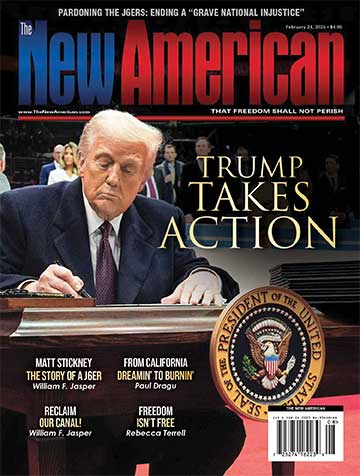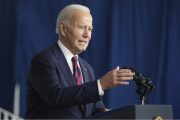
Anyone wondering why the U.S. economy seems to be stuck in neutral — or, in some sectors, even in reverse — need look no further than the latest American Action Forum (AAF) study to find one big reason why: federal regulations. According to the study, last year Washington imposed an additional $112 billion in regulatory costs and 157.9 million paperwork burden hours on Americans. That works out to $446 million and 629,000 paperwork hours for each day the federal government was open.
“From 2009 to 2013, regulators have published $494 billion in final rules,” penned AAF’s director of regulatory policy, Sam Batkins. “This figure dwarfs the Gross Domestic Product (GDP) from countries like Sweden, Peru, and Ireland.”
In 2013, 80,224 pages of regulations were added to the Federal Register, a 3.8-percent increase over 2012. The number of “economically significant” regulations increased by 25 percent, and the number of rules imposing “unfunded mandates on states or private entities” grew by 38 percent, Batkins found.
“Overall regulatory activity was up over 2012,” Batkins told CNSNews.com, in part because “the White House delayed some controversial rules until after the 2012 election.”
In fact, one of the most controversial rules, an Environmental Protection Agency (EPA) emissions standard that would force a two-thirds reduction in the amount of sulfur in gasoline, was “singled-out … for delay in 2012, as staffers disclosed reservations about the cost and likelihood of higher gas prices,” Batkins wrote. The EPA estimated that the rule would impose an additional $3.4 billion in costs and over 160,000 paperwork hours annually, with a total cost exceeding $35 billion. According to the Institute for Energy Research, consulting company Baker & O’Brien found that the rule “would impose upfront compliance costs of almost $10 billion on the refinery industry, resulting in a permanent increase in refining costs of 6 to 9 cents per gallon of gasoline. It will also increase the cost of vehicles. Thus, the proposed … standard would increase both the price of gasoline and the cost of buying a new car.”
The second most costly regulation of 2013 was the Department of Energy’s (DOE) proposed standards for commercial and industrial electric motors. That rule alone, Batkins argued, “would add $11.7 billion in long-term costs ($462 million annualized) and force some small manufacturers to spend 188 percent of their annual capital expenditures on compliance.” Many would surely go out of business.
Overall, DOE added $34.5 billion to Americans’ regulatory burden last year, including new energy-efficiency standards for microwaves, a rule the Obama administration claims will cost $1.3 billion but produce $3.5 billion in benefits by reducing the alleged “social cost of carbon” emissions — the “global warming” so evident across the United States, where temperatures have fallen below those in Antarctica in recent days.
As one might expect, ObamaCare has been a big driver of new, costly regulations. Last year, in the course of implementing the healthcare law, the Department of Health and Human Services (HHS) piled $2 billion in compliance costs and over 16.7 million paperwork burden hours onto the U.S. economy. HHS’s two largest regulations, a Medicare and Medicaid transparency rule and a final insurance exchange rule, added more than $3.2 billion in new costs and tens of thousands of hours in paperwork (55,000 hours for the exchange rule alone). The paperwork burden imposed by HHS is today 26 percent higher than it was in fiscal year 2011, Batkins notes, with much of that increase directly tied to ObamaCare.
ObamaCare is also adding to the paperwork burden via the Internal Revenue Service (IRS). In order for the IRS to enforce the individual mandate, it will have to burden Americans with an additional 7.5 million hours of paperwork. One can only hope the law’s authors saw fit to include carpal tunnel syndrome coverage among the many mandated benefits of ObamaCare-compliant health insurance.
Then there’s the implementation of the Dodd-Frank financial law. Last year it resulted in another $1.1 billion in compliance costs and 3.9 million in paperwork burden hours.
During the course of 2013, the cumulative paperwork burden from federal regulations increased by almost 158 million hours, to 10.38 billion hours. “To put this in perspective,” Batkins wrote, “it would take more than 78,000 employees working full-time to complete the additional paperwork.” Is it any wonder American businesses are struggling to get ahead when they have to expend so much effort complying with government edicts?
There is a small amount of good news among all the bad. Some agencies actually promulgated deregulatory measures. For instance, Batkins reported:
The Department of Transportation (DOT) published a surprising proposal that would generate $12.8 billion in benefits, reduce costs by $1.7 billion, and cut 46.6 million hours of paperwork, or 15 percent of the department’s total. The proposal would remove the requirement to file a report after every trucking trip, even if there is no incident, and instead require reports only for “defect” trips.
Other deregulatory measures, however, failed to reduce paperwork burdens and, in some cases, actually imposed new costs. Even the cost-cutting measures, unfortunately, were dwarfed by the new burdens, producing the net $112 billion in new regulatory costs, by AAF’s calculations. (At the beginning of 2013, AAF predicted those costs would reach $123 billion.)
This year, AAF is forecasting regulatory costs to increase to $143 billion, but much depends on politics. If the president fears his party will take another “shellacking” in the midterm elections as a result of burdensome regulations, he may choose to hold some of them in abeyance until 2015. On the other hand, Batkins observed in his remarks to CNSNews.com, “The president has three years in office. If he really wants to cement his regulatory legacy, now is the time to do it.”
With that in mind, President Obama has two options. He can continue on his merry way, regulating willy-nilly, leaving a legacy of economic malaise. Or he can choose to slash regulations and be known as the man who revived America. Which will it be, Mr. President?



